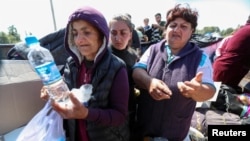The unprecedented influx of more than 100,000 refugees from Nagorno-Karabakh into Armenia in less than a week has triggered a humanitarian and health crisis that will require a large-scale, long-time international effort and support to resolve, aid officials warned Tuesday.
“The new arrivals need urgent emergency assistance,” said Marthe Everard, special representative of the World Health Organization regional director to Armenia.
“The Armenian government is doing everything it can—providing free transport to refugees to anywhere in the country and booking rooms in hotels and guest houses,” said the WHO official. “But the scale of the crisis is too large,” she said.
Based on an assessment mission over the weekend to Goris, a key point of entry for arriving refugees, Everard said, “It is clear that there are both short- and long-term health needs that demand our attention.”
Speaking in the Armenian capital, Yerevan, Everard said urgent treatment in the short term was needed for vulnerable people suffering from chronic conditions such as hypertension, diabetes, heart disease and cancer.
She also noted that infectious diseases including respiratory infections like COVID-19 and flu need to be monitored and treated. “Last but not least, mental health and psychosocial support is critical in these circumstances,” she added.
Everard said the WHO has increased its emergency aid to Armenia, deploying medical and trauma supplies and surge teams to support the Ministry of Health in helping people, including victims of a September 25 fuel depot explosion inside the enclave, located in Azerbaijan.
“Last week, the WHO dispatched burns kits to support the advanced care needed for hundreds of burns patients, some of whom we met at the National Burns Unit in Yerevan over the weekend,” she said. “It was heartbreaking to see human suffering of this scale.”
At least 170 people were killed in the explosion.
While the WHO and other U.N. and international aid agencies are providing relief to the many refugees who have arrived in Armenia, the International Committee of the Red Cross has been on the ground in Nagorno-Karabakh helping those who stayed behind.
Marco Succi, ICRC leader of the rapid deployment team, said that very few people are still in the enclave’s main city after the massive exodus, so “our teams have used megaphones to alert the remaining residents that we are there to help them.”
He said, “A couple of days ago, on the fourth floor of an apartment building, we found Susanna, an elderly cancer patient who was alone and unable to get out of her bed.
She had finished all her medication and could not take care of herself.”
After ensuring that she was stable, Succi said she was brought down a narrow staircase and evacuated by ambulance.
“On a personal note, I must say it is quite difficult to find the most vulnerable in need in circumstances like this and finding Susanna all on her own was an emotional moment,” he said, adding that moments such as this reveal the trials and tribulations of people left behind in the rush.
'Surreal' scene
Speaking in Stepanakert-Khankendi, he said the city was completely deserted. He also said the hospitals are not functioning and that medical and administrative personnel and other officials have left.
“The scene is quite surreal,” he said. “What was once a bustling city is now completely deserted, though essential water and electricity are still there. We see a few police on the streets to ensure security.”
He said it was not clear if looting is taking place. “Our teams have seen that some shops left their doors open and that residents who were not able to leave immediately entered and took some essential goods. We can presume the people who took these items were running low on food.”
Succi said the ICRC had as many as 25 people working in the city. Since the exodus took place, he said the ICRC has been able to help evacuate more than 200 wounded and sick patients, including people injured in the fuel depot explosion.
He said the ICRC team also has been able to transport the remains of 229 people who died during the conflict and the depot explosion. “The dignified treatment of the dead remains a key priority as is helping families find and identify their loved ones.”
He said the priority now was to find those in extreme need of medical treatment, the elderly and the mentally disabled people, adding, “Bringing essential food and supplies to the area also was of paramount importance.”









